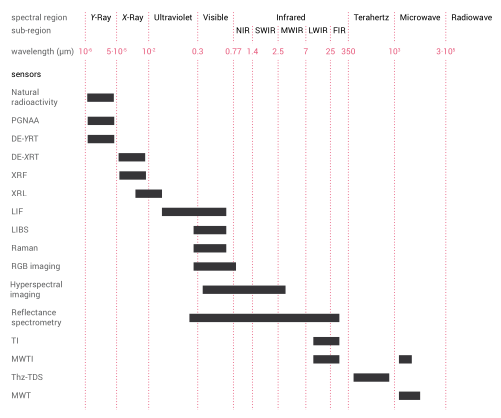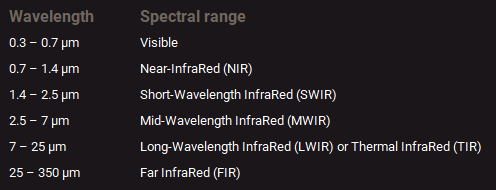The data that is obtained by nearly all sensors that are used to scan ores and rocks represents some kind of interaction with electromagnetic radiation, or light. Apart from the light that we can see with our eyes, electromagnetic radiation can have many other wavelengths. The different wavelength regions that are generally distinguished are shown in the figure below. This figure presents an overview of the wavelengths that are used by the different sensor technologies.
The phenomena that are measured with sensors usually involve the absorption or emission of light at certain wavelengths. These wavelengths are related to the energy of light particles, or photons. Because each element or mineral interacts with photons of a specific energy, the wavelength positions at which absorptions or emissions occur reveal information about the composition of an ore.
There are various physical processes that can produce absorption or emission of light. Some processes are related to changes in the energy state of an atom or chemical element, while others are produced by molecules bonds of minerals. Most sensor technologies measure just one specific type of process. Because of this, sensors can be categorised into processes related to chemical composition, mineralogy, or other properties such as density, heat capacity, or moisture content. An overview of all the different sensor technologies within these categories is given below.

The electromagnetic spectrum and wavelength regions on which different sensing technologies are based.
source: PhD thesis M.Dalm (2018 – TU Delft), https://doi.org/10.4233/uuid:70a1e180-ef0c-4226-9af3-7e9dc3938c7f
Chemical sensors
Chemical sensors measure interactions between electromagnetic radiation and atoms. They can be used to detect the chemical composition of materials in terms of the chemical elements such as Fe (iron), Cu (copper), S (sulphur), etc. This means that for most metal mines these sensor can provide direct information on ore grade. For each sensor, certain applicability restrictions apply such as detection limits or signal interferences by other elements. Such restrictions will be further explained in the [performance indicators] chapter.
X-ray fluorescence (XRF)
Shooting X-rays at a sample that are absorbed and returned at a different energy. Chemical composition is determined by measuring the energy spectrum of the returned X-rays.
Neutron activation analysis (NAA / PGNAA / PFTNA)
Bombarding an ore sample with neutrons to create short-lived radioactivity and gamma-ray (γ-ray) emissions. The gamma-ray spectrum reflects chemical composition.
Laser-induced breakdown spectroscopy (LIBS)
Using high-energy lasers to create bright plasmas on rock surfaces. Measuring the plasma light with a visible light spectrometer reveals the concentration of chemical elements.
Natural radioactivity
Certain elements such as thorium or uranium are naturally radioactive and therefore always produce gamma-rays. The concentration of these elements in a rock can be determined by measuring the radioactivity. In some cases the concentration of radioactive elements can be linked to ore grade.
Mineralogical sensors
Mineralogical sensors measure interactions between electromagnetic radiation and molecule bonds. In many cases it are the vibrations of molecule bonds that interact with light of specific energy and wavelength. Minerals are identified from certain combinations of absorption or emission features in a measured spectrum. The intensity of such features is related to mineral concentration.
Some mineralogical sensors can be used to accurately measure subtle chemical alterations within minerals, which are often geologically related to ore mineralization. These differences cannot be measured with chemical sensors because the different minerals are chemically similar, but have a different arrangement of atoms and molecular structure. The information on alteration provided by the sensor can sometimes be used for indirect detection of ore grade.
Reflectance spectroscopy
Using a spectrometer to measure reflected light from rock surfaces. Various minerals and other rock properties can be detected from these spectra. Due to differences in the required spectrometer hardware for measuring certain wavelength regions, reflectance spectroscopy is usually sub-divided into the regions shown in the table below.

Hyperspectral imaging
A technology that is used to measure images in which each pixel is a spectrum. Usually refers to line-scan imaging in the visible and infrared spectral regions. Strictly speaking any spectral sensor could be used to generate a hyperspectral image by simply measuring a raster of points.
Raman spectroscopy
Using a laser to measure the Raman scattering effect with a visible or infrared spectrometer. Many different types of minerals can be detected with this technique.
Magnetic resonance (MR / MRI)
Creating a strong magnetic field to cause resonances in the atomic nuclei of a mineral within the ore. Mineral concentration can be determined by measuring these resonances.
Laser-induced fluorescence (LIF) & x-ray luminescence (XRL)
Using a laser or x-ray source to create a fluorescence effect in certain minerals. These sensors are often applied in the diamond mining sector for diamond identification and sorting. Applications are limited because not many minerals produce a fluorescence effect.
Other sensors
Measuring other properties of ores and rocks that may provide an indication of ore type and grade.
RGB imaging
Regular cameras measure light intensity on the red, green, and blue regions of the visible spectrum. Available in many different forms as OEM components. Can be used to distinguish certain rock types by using machine learning for image recognition.
X-ray transmission (DE-XRT) & gamma-ray transmission (DE-γRT)
Measuring the transmission of x-rays or gamma-rays (γ-rays) through a material reveals differences in density. Well-known technology used in airport luggage scanners. Applicable for characterizing ore grades when ore minerals have a different density than other minerals in the rock.
Electromagnetic conductivity (EM)
Measuring disturbances in an electro-magnetic field when an ore material passes through it. Can be used to detect the quantity of electrically conductive minerals.
Thermal imaging (TI)
Using an infrared camera to map black-body temperature differences. Such differences can exist within rock formations due to the occurrence of geological structures such as faults. It can therefore be useful in mapping mineralised zones by scanning mining faces.
Microwave heating and thermal imaging (MWTI)
Using microwave radiation to heat up rocks and then measuring temperature differences after some heating and cooling period with an infrared camera. This reveals differences in the thermal capacity and conductivity of the rocks, which can sometimes be related to different ore types and ranges of grade.
Microwave transmission (MWT)
The transmission of microwaves through a material is strongly affected by the presence of water. Microwave transmission sensors are therefore excellent tools for measuring the moisture content of materials on conveyor belts. This type of sensing for moisture content is widely applied in various industries.

